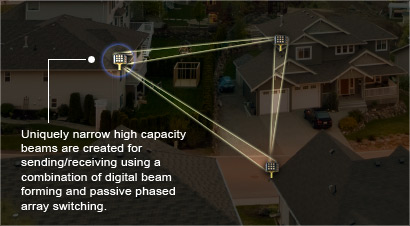
Out of the box, a single Gigaband Community Network Starter Pack will consist of 30 roof-mountable Subscriber Nodes, 1 Anchor Point Kit, and a Network Optimizing Server (NOS). The Starter Pack will includes all the components needed to serve the first 30 users in a new Gigaband community. Anchor Points can be mounted on low profile buildings, (for example coffee shops). Each Anchor Point aggregates traffic from up to three hops of Gigaband Subscriber Nodes. Every node deployed should be within a quasi-
 line-of-sight two to three mile range of two or three other nodes. This pattern of node deployments will create service footprints of 10 to 40 sq. miles, making the service potentially available to as many as 3,000 to 10,000 homes in a community depending on neighborhood housing densities. Quasi-line-of-sight means that signals can be expected to pass through reasonable amounts of foliage in the path between any two nodes. However if serious physical obstacles or significant radio interference are blocking a path between two nodes, the nodes are programmed to immediately fall back to aiming at other nodes in different directions that are not blocked. This ability to use redundant alternate physical paths when needed is what gives Gigaband its dramatically higher connection reliability when compared to other wireless network architectures such as point-to-multipoint or conventional mesh networking.
line-of-sight two to three mile range of two or three other nodes. This pattern of node deployments will create service footprints of 10 to 40 sq. miles, making the service potentially available to as many as 3,000 to 10,000 homes in a community depending on neighborhood housing densities. Quasi-line-of-sight means that signals can be expected to pass through reasonable amounts of foliage in the path between any two nodes. However if serious physical obstacles or significant radio interference are blocking a path between two nodes, the nodes are programmed to immediately fall back to aiming at other nodes in different directions that are not blocked. This ability to use redundant alternate physical paths when needed is what gives Gigaband its dramatically higher connection reliability when compared to other wireless network architectures such as point-to-multipoint or conventional mesh networking.
 line-of-sight two to three mile range of two or three other nodes. This pattern of node deployments will create service footprints of 10 to 40 sq. miles, making the service potentially available to as many as 3,000 to 10,000 homes in a community depending on neighborhood housing densities. Quasi-line-of-sight means that signals can be expected to pass through reasonable amounts of foliage in the path between any two nodes. However if serious physical obstacles or significant radio interference are blocking a path between two nodes, the nodes are programmed to immediately fall back to aiming at other nodes in different directions that are not blocked. This ability to use redundant alternate physical paths when needed is what gives Gigaband its dramatically higher connection reliability when compared to other wireless network architectures such as point-to-multipoint or conventional mesh networking.
line-of-sight two to three mile range of two or three other nodes. This pattern of node deployments will create service footprints of 10 to 40 sq. miles, making the service potentially available to as many as 3,000 to 10,000 homes in a community depending on neighborhood housing densities. Quasi-line-of-sight means that signals can be expected to pass through reasonable amounts of foliage in the path between any two nodes. However if serious physical obstacles or significant radio interference are blocking a path between two nodes, the nodes are programmed to immediately fall back to aiming at other nodes in different directions that are not blocked. This ability to use redundant alternate physical paths when needed is what gives Gigaband its dramatically higher connection reliability when compared to other wireless network architectures such as point-to-multipoint or conventional mesh networking.
Additional Subscriber Nodes (one for each new subscriber) are expected to cost $100 or less after volume production is achieved. With only 10% penetration of a 3,600 home community, or 360 live-subscribers, the all-in deployment cost is expected to be a disruptive $309 per subscriber. At 720 subscribers, it may be less than $253. A single Gigaband Anchor Point is normally expected to serve up to 500 subscribers before another Anchor Point needs to be installed depending on the types of services offered across the network.

